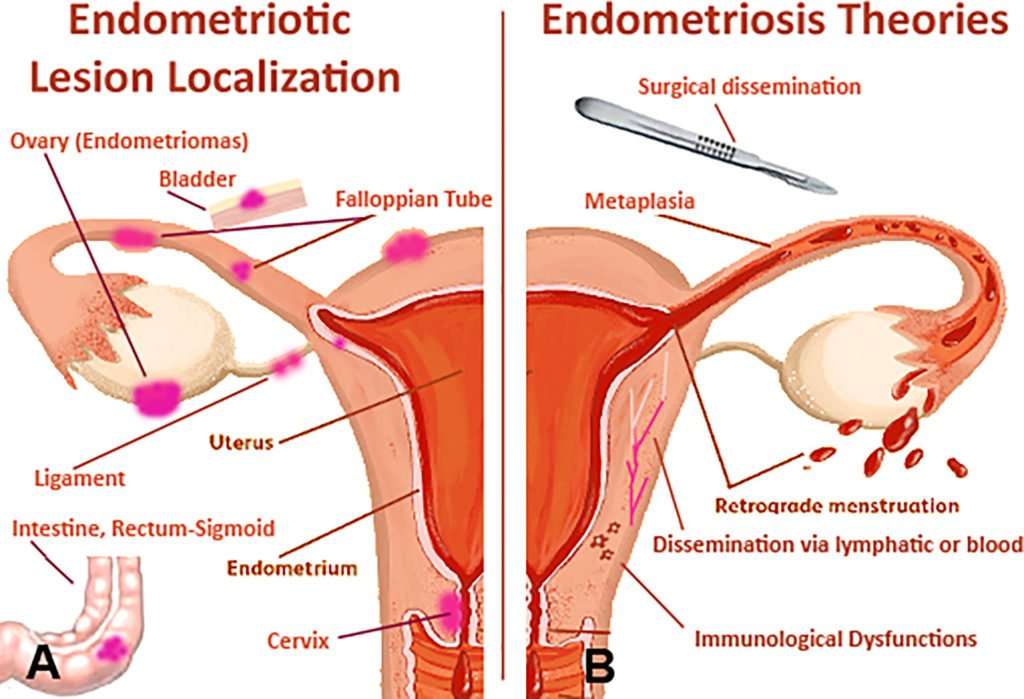Treatment of Endometriosis at HeyPills includes specially chosen and formulated Homeopathy medicines for endometriosis. The treatment protocol has been developed after exhaustive in-house research and has to be tailor-made and customized for you by our specialists. Our clinics consult more than 7500 patients of Endometriosis globally, every year. You too can be benefitted by our expertise in the treatment of endometriosis.
See our specialists at any HeyPills in India or order online instantly from the link above.
Is Homeopathy The Best Treatment of Endometriosis?
Yes, Because Homeopathy can cure endometriosis completely.
- Specially formulated Homeopathy medicines for Endometriosis from Welling Clinics are proven to work in our patients from 108 countries,
- The homeopathy treatment for Endometriosis can help you get cured of all major symptoms of Endometriosis including extreme pain during periods,
- Once the treatment of Endometriosis is complete, the symptoms rarely return,
- You get faster relief due to our newly researched homeopathy medicines at Welling Research Labs.
Call +91 9999064336 to book an appointment or to consult and order online. Consult our specialists today for a detailed evaluation and to start your customised Homeopathy medicines for Endometriosis.

Aashaya Mahendra, India
I started my treatment for endometriosis through online consultation and later visited the clinic. Majority of my health problems related to endometriosis got resolved in 4 months and I was pain-free within 8 months. Doctors here declared me completely cured of endometriosis in 11 months and i was off any treatment.
What is Endometriosis?
The endometrium is the tissue that lines the inside of the womb (uterus).
Endometriosis is the abnormal growth of cells (endometrial cells) similar to those that form the inside or lining the tissue of the uterus but in a location outside of the uterus.
Endometrial cells are the lining cells of the uterus and are cells that are shed each month during menstruation.
Endometriosis occurs when cells like the lining of the uterus grow in or on tissues outside the uterus; these areas are called endometriosis implants.
These implants are most commonly found on the ovaries, the Fallopian tubes, outer surfaces of the uterus or intestines, and on the surface lining of the pelvic cavity. They can also be found in the vagina, cervix, and bladder, although less commonly than other locations in the pelvis.
Rarely, endometriosis implants can occur outside the pelvis, on the liver, in old surgery scars, and even in or around the lung or brain.
Endometrial implants, while they can cause problems, are benign (not cancerous).
Leena G.S, US.
I heard about you from my friend here in Chicago. I was troubled by endometriosis for 12 years. I consulted your doctor in early 2017. I was completely pain-free within 4 months. I conceived in 7 months of starting your treatment
Causes of Endometriosis
Currently the exact cause of endometriosis is unknown. Most experts agree that there are many responsible factors, possibly including genetic, immunological, and hormonal reasons. But following theories are been proposed:
1.Retrograde menstruation:One theory is that the endometrial tissue is deposited in unusual locations by the backing up of menstrual flow into the Fallopian tubes and the pelvic and abdominal cavity during menstruation (termed retrograde menstruation). The cause of retrograde menstruation is not clearly understood. But retrograde menstruation cannot be the sole cause of endometriosis. Many women have retrograde menstruation in varying degrees, yet not all of them develop endometriosis.
2.Coelomic metaplasia:
- Another possibility is that areas lining the pelvic organs possess primitive cells that are able to grow into other forms of tissue, such as endometrial cells. (This process is termed coelomic metaplasia.)
- It is also likely that direct transfer of endometrial tissues during surgery may be responsible for the endometriosis implants sometimes seen in surgical scars (for example, episiotomy or Cesarean section scars).
- Transfer of endometrial cells via the bloodstream or lymphatic system is the most likely explanation for the rare cases of endometriosis that develop in the brain and other organs distant from the pelvis.
- Finally, there is evidence that shows alternations in the immune response in women with endometriosis, which may affect the body’s natural ability to recognize and destroy any misdirected growth of endometrial tissue.
- Patches of endometriosis tend to be ‘sticky’ and may join organs to each other. The medical term for this is adhesions. For example, the bladder or bowel may ‘stick’ to the uterus. Large patches of endometriosis may form into cysts which bleed each month when you have a period. The cysts can fill with dark blood; this is known as ‘chocolate cysts’.
Afiya Humranwala, India
I was cured of endometriosis in 13 months and all thanks to you all doctors at Welling I am back to my routine jogging and sports.
Symptoms of Endometriosis
Patches of endometriosis can vary in size from the size of a pinhead to large clumps. Many women with endometriosis have no symptoms. If symptoms develop they can vary, and include those listed below.
In general, the bigger the patches of endometriosis, the worse the symptoms. However, this is not always the case. Some women have large patches of endometriosis with no symptoms. Some women have just a few spots of endometriosis, but have bad symptoms.
- Painful periods: The pain typically begins a few days before the period and usually lasts the whole of the period. It is different to normal period pain which is usually not as severe, and doesn’t last as long.
- Type of Pain: Throbbing, gnawing, and dragging pain to the legs are reported more commonly by women with endometriosis, Compared with women with superficial endometriosis, those with deep disease appear to be more likely to report shooting rectal pain and a sense of their insides being pulled down.
- Painful sex. The pain is typically felt deep inside, and may last a few hours after sex.
- Pain in the lower tummy (abdomen) and pelvic area. Sometimes the pain is constant, but is usually worse on the days just before and during a period.
- Endometriosis lesions react to hormonal stimulation and may “bleed” at the time of menstruation. The blood accumulates locally, causes swelling, and triggers inflammatory responses with the activation of cytokines.
- Other menstrual symptoms may occur. For example, bleeding in between periods.
- Difficulty becoming pregnant (reduced fertility). This may be due to clumps of endometriosis blocking the passage of the egg from an ovary to the Fallopian tube.
- Other symptoms include pain on passing poo (faeces), pain in the lower abdomen when you pass urine, and, rarely, blood in the urine or faeces.
- Very rarely, patches of endometriosis occur in other sites of the body. This can cause unusual pains in parts of the body that occur at the same time as period pains.
- Endometriotic lesions can develop their own nerve supply, thereby creating a direct and two-way interaction between lesions and the central nervous system, potentially producing a variety of individual differences in pain that can, in some women, become independent of the disease itself.
Vikram Singh, Rajasthan, India
I and my wife started the treatment of infertility. My wife suffered from endometriosis and it was difficult for her to conceive. We even tried IVF, which failed, So we turned to HeyPills . The pains reduced within the first month and the regular treatment continued for the next 5 months when I got the pleasant news of my wife conceiving. Thank you .
Complications of Endometriosis
If endometriosis is left untreated, it becomes worse in about 4 in 10 cases. It gets better without treatment in about 3 in 10 cases. For the rest it stays about the same. Endometriosis is not a cancerous condition.
Complications sometimes occur in women with severe untreated endometriosis. For example, large patches of endometriosis can sometimes cause a blockage (obstruction) of the bowel or of the tube from the kidney to the bladder (the ureter).
Once the endometriosis has gone with treatment, it may recur again in the future. Further treatment may need to be considered if symptoms recur.
Diagnosis of Endometriosis
How is Endometriosis Diagnosed?
- Endometriosis can be suspected based on symptoms of pelvic pain and findings during physical examinations in the doctor’s office
- Unfortunately, neither the symptoms nor the physical examinations can be relied upon to conclusively establish the diagnosis of endometriosis.
- Imaging studies, such as ultrasound, can be helpful in ruling out other pelvic diseases and may suggest the presence of endometriosis in the vaginal and bladder areas, but still cannot definitively diagnose endometriosis.
- For an accurate diagnosis, a direct visual inspection inside of the pelvis and abdomen, as well as tissue biopsy of the implants are necessary.
- Laparoscopy is the most common surgical procedure for the diagnosis of endometriosis. During laparoscopy, biopsies (removal of tiny tissue samples for examination under a microscope) can also be performed for a diagnosis. Sometimes biopsies obtained during laparoscopy show endometriosis even though no endometrial implants are seen during laparoscopy.
Staging of Endometriosis
Surgically, endometriosis can be staged I–IV (Revised Classification of the American Society of Reproductive Medicine). The process is a complex point system that assesses lesions and adhesions in the pelvic organs, but it is important to note staging assesses physical disease only, not the level of pain or infertility. A person with Stage I endometriosis may have little disease and severe pain, while a person with Stage IV endometriosis may have severe disease and no pain or vice versa. In principle the various stages show these findings:
Stage I (Minimal)
Findings restricted to only superficial lesions and possibly a few filmy adhesions
Stage II (Mild)
In addition, some deep lesions are present in the cul-de-sac
Stage III (Moderate)
As above, plus presence of endometriomas on the ovary and more adhesions.
Stage IV (Severe)
As above, plus large endometriomas, extensive adhesions.
Endometrioma on the ovary of any significant size (Approx. 2 cm +) must be removed surgically because hormonal treatment alone will not remove the full endometrioma cyst, which can progress to acute pain from the rupturing of the cyst and internal bleeding.
Endometrioma is sometimes misdiagnosed as ovarian cysts.
Treatment of Endometriosis
While there is no cure for endometriosis, there are two types of interventions; treatment of pain and treatment of endometriosis-associated infertility.
- In women in the reproductive years, endometriosis is merely managed: the goal is to provide pain relief, to restrict progression of the process, and to restore or preserve fertility where needed.
- In younger women with unfulfilled reproductive potential, surgical treatment attempts to remove endometrial tissue and preserving the ovaries without damaging normal tissue.
- Pain Management: Nonsteroidal anti-inflammatory drugs or NSAIDs (such as ibuprofenor naproxensodium) are commonly prescribed to help relieve pelvic pain and menstrual cramping. These pain-relieving medications have no effect on the endometrial implants.
- Hormone therapy
- Birth control hormones (patch, pills, or ring) stop monthly ovulation and the growth, shedding, and bleeding that makes endometriosis painful. Birth control hormones improve endometriosis pain for most women. And they are the hormone therapy that is least likely to cause bad side effects.
- Gonadotropin-releasing hormone agonist (GnRH-a)therapy lowers estrogen, triggering a state that is like menopause. This shrinks implants and reduces pain for most women.
- Progestin (pills or Depo-Proverashot) stops ovulation and lowersestrogen. For most women, it shrinks endometriosis growths and reduces pain.
- Danazol therapy lowers estrogen levels and raises androgen levels, triggering a menopause-like state. This shrinks growths and reduces pain for most women. This relief usually lasts for 6 to 12 months after treatment. But danazol side effects can be significant.
All hormone therapies for endometriosis can cause side effects and pose certain health risks. Some cause especially unpleasant side effects. Before starting a medicine or hormone therapy, review its possible side effects. If they sound less difficult than your endometriosis symptoms, discuss the therapy with your doctor.
- Surgery: Sometimes an operation is advised to remove some of the larger patches of endometriosis. An operation may ease symptoms and increase the chance of pregnancy if infertility is a problem. If you have completed your family, and other treatments have not worked well, removal of the womb (uterus) – a hysterectomy- and removal of the ovaries may be an option.
Homeopathic Treatment For Endometriosis
Homeopathic remedies are prescribed by symptoms rather than conditions, as each case of a particular illness can manifest differently in different people.
Homeopathy is one of the most popular holistic systems of medicine. The selection of remedy is based upon the theory of individualization and symptoms similarity by using holistic approach.
This is the only way through which a state of complete health can be regained by removing all the sign and symptoms from which the patient is suffering.
The aim of homeopathy is not only to treat endometriosis but to address its underlying cause and individual susceptibility.
As far as therapeutic medication is concerned, several remedies are available to treat endometriosis that can be selected on the basis of cause, sensations and modalities of the complaints.
For individualized remedy selection and treatment, the patient should consult a qualified homeopathic doctor in person. There are following remedies which are helpful in the treatment of endometriosis:
Aconite, Arsenic Album, Belladonna, Bryonia, Cimicifuga, Gelsemium, Iodium, Pulsatilla, Sabina, Secale Cor, Sepia, Silicea, Aurum Mur, Calcaria Carb, Carbolic Acid,
Homeopathy is a holistic treatment; therefore the homeopathic medicine not only treats fibroid but also improves overall health.
Common Questions regarding Endometriosis:
Can Endometriosis Cause Cancer?
Yes Ovarian cancer occurs at higher than expected rates in women with endometriosis, Since endometriosis is the reason for infertility in 50% of women who cannot conceive, the explanation may have something to do with the lack of having children. Conceiving and giving birth is known to offer some protection against ovarian cancer. The scientist discovered that the risk for cancer among women with endometriosis was elevated by 90% for ovarian cancer, 40% for hematopoietic cancer (primarily non-Hodgkin’s lymphoma), and 30% for breast cancer.
Estrogen stimulates cell division in the ovaries, breasts and uterus. Over time, those constantly dividing cells might make a mistake, leading to cells dividing uncontrollably, i.e., a cancer. Endometriosis, on the other hand, is the presence elsewhere in the body of tissue that normally lines the uterus. This tissue also grows in response to estrogen, and the disease itself is dependent on the presence of estrogen.
Can Endometriosis Go Away?
For most women, endometriosis recedes with menopause. Some women find relief from endometriosis during pregnancy. In some cases, symptoms may simply go away. About one-third of women with mild endometriosis will find that their symptoms resolve on their own.
Can Endometriosis Spread?
yes -It is a benign but it is locally invasive, disseminates widely. Cyclic hormones stimulate growth. Symptoms are not related with extent of lesion.Even when the endometriosis is widespread,there may not be any symptom; conversely, there may be intense symptoms with minimal endometriosis.
Can Endometriosis Cause Backpain?
Yes – back pain, leg & hip pain, acid reflux, chronic fatigue, and many other symptoms that don’t appear to be related to the pelvic area may be due to nerve damage, inflammation, lesions, and/or adhesions that are adjacent to the spinal cord. When endometriosis infiltrates nerves near to the spinal cord, for example, it can cause radiating pain throughout the region.
Surgically removing endometriosis from this and other nerves can help reduce these symptoms. However, only the most advanced laparoscopic surgeons can remove endometriosis from nerves minimally invasively without causing complications
Can Endometriosis Cause Nausea?
Yes , The liver is our filter and would pick up any particles that weren’t ideal for the body and flush them away, through our digestive system. The trouble occurs however when the liver is being overworked and doesn’t have enough capacity to process all the toxins that come through. This generally occurs because there is a backlog of toxins, which the liver has to process.so yes endometriosis has indirect way of causing nausea especially during menstrual periods which might be linked with liver having stress of overwork.
Can Endometriosis Be Fatal?
Sometimes the endometrial cells create cysts that can rupture and bleed. The process sounds a bit like cancer, but endometriosis isn’t cancer. However, it may very slightly increase the risk of getting certain cancers. Endometriosis isn’t a fatal disease but can be widespread.
Can endometriosis cause anemia?
Chronic blood loss canalso be due to endometriosis. One of those facts is that the Endometriosis implants/lesions shed (or bleed) inside the pelvic cavity (or wherever else the Endo is located). Another fact is that women with Endometriosis tend to have much longer and heavier periods than women who do not suffer from Endo. so mostly Iron –deficiency anemia chances are high.
Can endometriosis cause leg pain?
Not quite sure what connects endometriosis to leg pain but the endometrial cells caused nerve inflammation in the areas close to the uterus.It’s also possible that the nerves themselves become trapped in the endometriosis tissue.
Can endometriosis cause fever ?
Surely it has not yet proved but R. Holmes reported 80 cases of endometriosis of which seven, or 8.7 per cent, had a temperature elevation and leukocytosis. Jeffcoate9 in 1947 reported 8 instances of fever occurring in 91 cases of proved endometriosis which were operated upon.
Can endometriosis cause bleeding?
Yes, Rectal bleeding and haematuria during menstruation may occur in women with infiltrating rectosigmoidal and bladder endometriosis, respectively. Hemoptysis (rarely)
Can endometriosis cause fatigue?
As a matter of fact the symptoms often associated with endometriosis such as chronic fatigue, allergy, emaciation and poor complexion are not caused directly by endometriosis but are signs of liver disorders. A better alternative however is to strengthen the liver so that it can more efficiently inactivate and remove estrogen.
Women of reproductive age with endometriosis may experience fatigue/exhaustion, abdominal bloating, diarrhoea/painful bowel movements with menstruation, pain during or after sex, heavy or irregular bleeding, nausea/stomach upsets with menstruation, dizziness/headaches with menstruation, low resistence to infection.
Can endometriosis cause hair loss?
Endometriosis is a biological disorder that mostly affects women between the ages of 25 and 35. It is believed endometriosis and hair loss are indirectly linked through hormones, stress and medication. Lastly, there are some medications used to treat endometriosis that list hair loss as a side effect. Danocrine, or Danazol is a progestogen which can lead to masculinised traits, including increased facial and body hair, and thinning hair or hair loss. Lupron is another medication suggested for the treatment of endometriosis, but it can induce hair loss and slow down the regular growth of hair in a woman.
Can endometriosis be cured?
Endometriosis can be completely cured with Welling Homeopathy. The treatment can help with pain and infertility. Treatment depends on how severe your symptoms are and whether you want to get pregnant. Also good scope of homoeopathy in hormonal disorders.
Can endometriosis cause bladder pain?
Endometrial tissue present in the rectum or urinary tract can cause an obstruction. Endometriosis affecting the bladder is rare and the exact cause is unknown. Bladder irritation, Bladder urgency (the need to pass urine),Pain when the bladder is full, Occasional blood in the urine during a period.In some cases, loin pain in the area of the kidneys
Can endometriosis cause depression?
The association between endometriosis and psychological disorders has been reported in several previous studies, with depression and anxiety being the most common conditions. The incidence of such symptoms is higher in women with endometriosis than in any other gynecological condition.w omen with endometriosis commonly suffer from chronic pelvic pain (CPP).
Research studies have highlighted the influence CPP can have on patients’ quality of life and psychological well-being. The use of hormonal therapies such as gonadotropin-releasing hormone agonists (GnRH) are effective at reducing endometriosis symptoms, but they are often associated with anxiety and depression.
Can endometriosis cause infertility?
In patients with endometriosis,the activated macrophages secrete several factors like cytokines, interleukin–1, α TNF, integrins and angiogenic factors. These factors promote the growth of endometrial cells over the ectopic sites.these activated macrophages reduce sperm motility, increase sperm phagocytosis and interfere with fertilization.It usually involves the ovaries and results in adnexal adhesions that by reducing tubo-ovarian motility impede pick-up function
Can I get pregnant with endometriosis?
It’s important to know that, with treatment, the majority of women with endometriosis and infertility issues eventually do become pregnant. Studies find that about 21 to 44 percent of infertile women have endometriosis, but only 4 to 22 percent of fertile women.It also doesn’t mean you won’t or can’t get pregnant.








